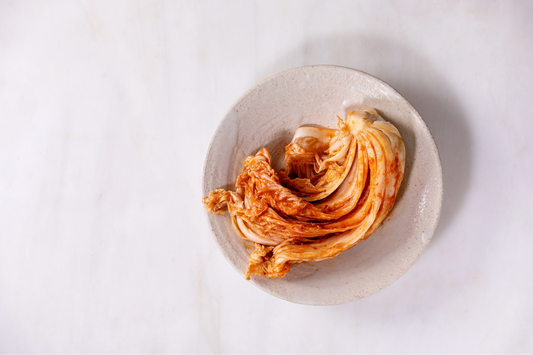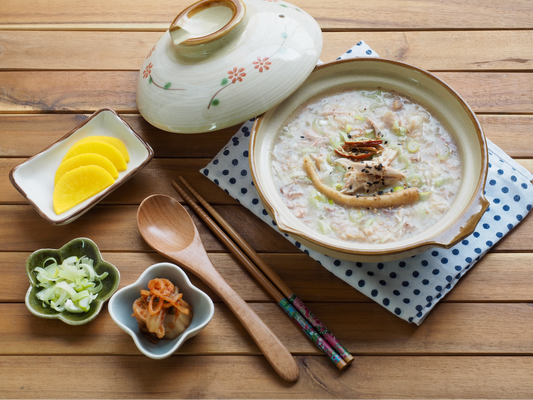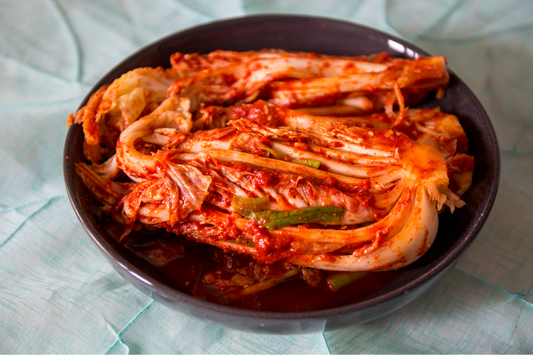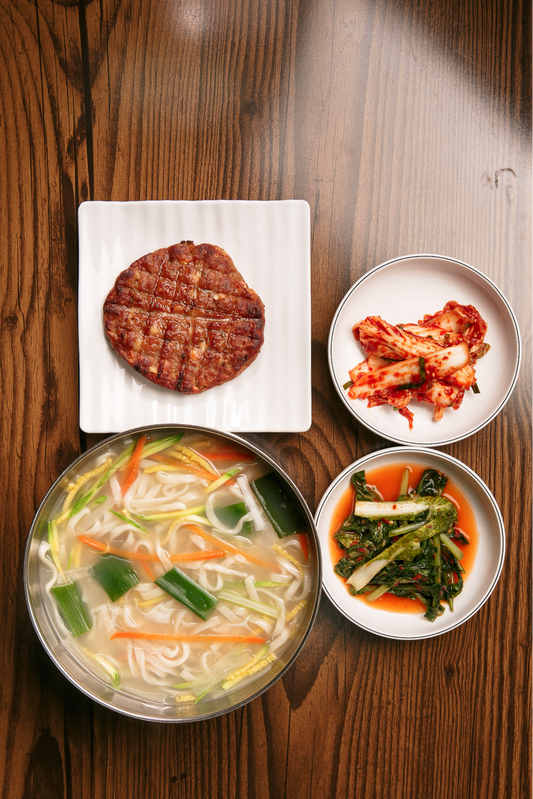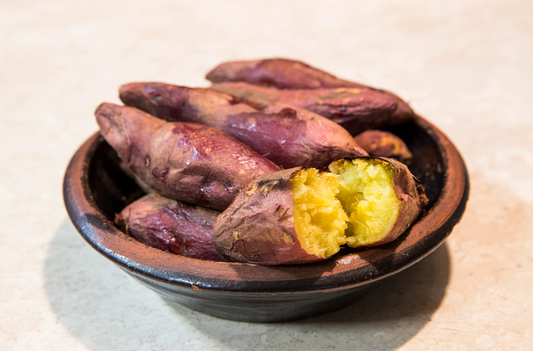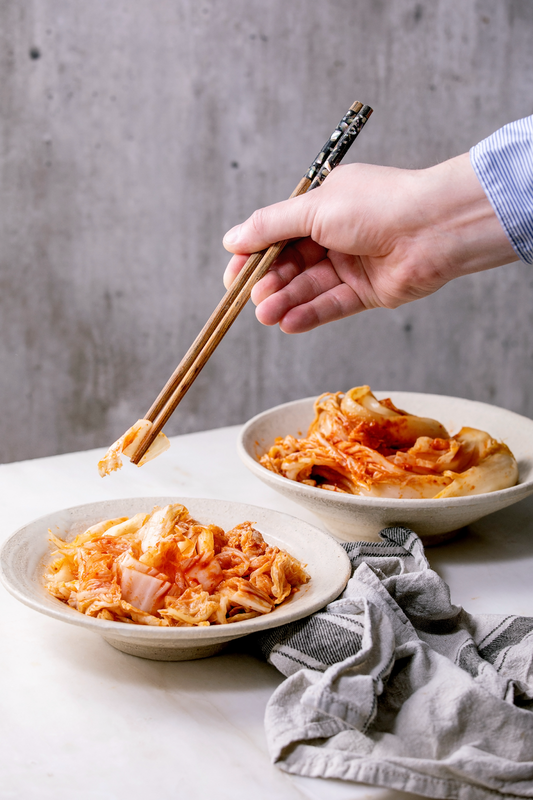Ever thought the kimchi on your plate is more than just tasty? It's a source of seasonal probiotic benefits. Famous for its bright flavors and kimchi health advantages, this Korean fermented food is a standout. But could kimchi be even better for you in different seasons? We dive into kimchi's world to explore how its seasonal varieties, fermentation methods, and best practices keep it fresh all year.
Key Takeaways
- Discover how the fermentation process enriches kimchi with essential nutrients and probiotics, influencing immunity and metabolism.
- Understand the significance of seasonal ingredients in enhancing the nutrient profile and efficacy of kimchi’s health benefits.
- Learn the optimal fermentation storage methods that vary by season to preserve the distinct flavors and longevity of kimchi.
- Recognize the importance of managing kimchi freshness for maximizing both its taste and nutritional value.
- Gain insights into how scientific studies attribute reduced risk factors for chronic diseases to regular kimchi consumption.
- Explore the potential of specific probiotics in kimchi to combat various health concerns from gastrointestinal issues to heart disease.
- Acquire knowledge on safe preparation and storage practices at home to avoid contamination by harmful bacteria like Escherichia coli.

Benefits and Advantages of Kimchi by Season
The unique seasonal kimchi benefits come from fresh ingredients available each season. Fermented vegetable health properties are key to kimchi's benefits. Kimchi is renowned not only as a fermented food but also as a source of probiotics.
In spring, fresh vegetables are used to make kimchi. These ingredients are full of essential nutrients. As it gets warmer, kimchi helps with hydration, thanks to ingredients like cucumbers. Eating kimchi regularly is good for digestion and immune support, studies show.
Autumn kimchi warms the body as temperatures drop. It's rich in vitamins A, B, and C, plus minerals like selenium. Through fermentation, these nutrients help boost immune health. In winter, kimchi becomes heartier. Added spices help warm the body in the cold.
The fermentation is crucial in making any traditional Korean dish. It improves kimchi's health properties, boosting beneficial gut bacteria. According to The Journal of Ethnic Foods, eating more kimchi diversifies gut microbes. It increases good bacteria like Faecalibacterium and reduces bad ones like Escherichia coli.
Seasonal kimchi benefits are impressive, but safety in fermentation and storage is key. If done right, kimchi not only makes meals tastier. It also boosts health and well-being. This makes it a valuable part of a healthy diet all year.

Health Benefits of Kimchi by Season
Kimchi shows different health benefits throughout the year. This highlights its nutritional variety and how it uses seasonal ingredients. By exploring these changes, we learn about unique health benefits. These benefits come from different ways to ferment and various ingredients, improving our health with what nature offers.
Advantages of Spring Kimchi: Health Benefits Provided by Spring Kimchi
In spring, nature wakes up and offers fresh vegetables, making spring kimchi health valuable. This period's kimchi includes radishes and spring onions. These add vitamins and enzymes to our diet, helping to clean our bodies after winter.
Advantages of Summer Kimchi: Impact of Summer Kimchi on Heat Relief and Body Fluid Balance
The summer kimchi diet fights the summer heat. Summer kimchi uses cucumbers and perilla leaves. These are great for staying hydrated and cool. Such kimchis are less spicy and pair well with barbecues and cold noodles, perfect for hot weather.
Advantages of Autumn Kimchi: Warming Effects of Autumn Kimchi on the Body
When autumn arrives, autumn fermented vegetables help warm the body. They offer better nutrition. Cabbage and radish are common, spiced up for autumn. These help with digestion and boost our immune system for winter.
Advantages of Winter Kimchi: How Winter Kimchi Contributes to Maintaining Body Temperature and Enhancing Immunity
Winter kimchi nutrients are crucial in the cold months. They include a lot of garlic and ginger, which boost the immune system. This kimchi variety helps keep us warm. It's a tasty way to fight off the cold.
Kimchi’s preparation changes with the seasons, delighting taste buds and meeting nutritional needs. It's a tradition that keeps us healthy all year.

Changes in Kimchi Flavor and Texture by Season
The seasons strongly influence kimchi's flavors. This is mainly because of the different ingredients available at each time. Knowing how these aspects influence kimchi taste variation and kimchi texture deepens our love for this Korean dish.
Freshness of Ingredients: How Fresh Seasonal Ingredients Affect the Flavor and Texture of Kimchi
Freshness is key for high-quality kimchi. Seasonal ingredients mean vegetables are nutritionally best and very flavorful. For instance, cabbages in cooler months are crisp. This makes kimchi firmer and tastier.
Studies have found fresh cabbage creates different fermentation than older cabbage. This difference affects the kimchi's texture and fermentation profile.
Differences in Kimchi Fermentation: Seasonal Differences in the Fermentation Process and Changes in Flavor
The fermentation flavor differences in kimchi change with the seasons. Warm seasons make the fermentation faster. This results in a tangy kimchi quickly. Cooler seasons, however, slow it down, leading to milder flavors.
This results in different amounts of mannitol and lactic acid in kimchi. These differences affect its sourness and flavor depth. Understanding this helps both companies and home cooks make top-notch kimchi all year.
The mix of seasonal ingredient freshness, fermentation flavor differences, and kimchi texture offers a variety of tastes. These vary by recipe and the time of year kimchi is made and eaten.

Storage and Management of Kimchi by Season
It's key to manage seasonal kimchi storage well to keep up the nutritional content and preserving kimchi freshness all year. Each season brings different ingredients, from spring's water parsley to winter's white radish. These influence the flavors and how we handle fermentation management. For example, winter's cool temperatures slow down fermentation. This slow process is perfect for creating Dong-chi-mi, a crunchy and refreshing radish kimchi.
Summer brings its own set of challenges due to the heat speeding up fermentation. This time of year, attention to how we store kimchi is crucial to stop it from fermenting too much. Using fridges is recommended. Yet, it's important to understand that while kimchi ferments faster in the cold, it might not stay as crisp. To deal with this, using Ong-gi jars that let kimchi "breathe" and keep air out helps in preserving kimchi freshness.
Fall and spring offer milder weather, but each still demands specific storage steps to keep the nutritional content and taste right. Introducing new ingredients in spring, like mustard leaf, leads to unique fermentation needs. Adjusting saltiness and spices is essential for successful seasonal kimchi storage.
"Given the variety of seasonal ingredients and regional preferences, careful monitoring and adaptation of fermentation practices and storage methods are vital in keeping the traditional flavors and health benefits intact," notes researcher Youngbin Kim.
Adapting fermentation and storage methods for seasonal changes and different regions is a must. In Northern Korea, recipes are less salty and spicy, affecting the Lactic Acid Bacteria that are vital for kimchi's health perks. A flexible approach to fermentation management and careful seasonal kimchi storage keeps kimchi's valued taste and health benefits going strong throughout the year.
How to Store Kimchi
Properly storing kimchi involves understanding kimchi preservation, fermentation control, and seasonal storage guidelines. It's crucial to keep kimchi safety in mind, given the different needs throughout the year.
Optimal Storage Temperature by Season: Ideal Storage Temperatures for Kimchi Depending on the Season
Kimchi needs different temperatures depending on the season. In warm months, keep it in a fridge under 4 degrees Celsius. This slows fermentation and stops it from spoiling.
During winter, a slightly warmer fridge temperature helps control fermentation. This balance maintains kimchi's taste and texture. It also uses its acidic pH of 4.5 to stop harmful bacteria.
Fermentation Status and Management: Methods for Checking and Managing Kimchi Fermentation by Season
To manage kimchi fermentation, check its condition often. Look for changes in taste, texture, and appearance. White spots sometimes seen are actually safe yeast colonies, not mold.
Remove these yeasts by washing and cooking kimchi to keep its flavor and safety. Use clean utensils and seal it in brine to extend shelf life and safety. Monitoring fermentation helps avoid overfermentation, keeping the flavor and nutrients intact.
How to Maintain Kimchi Freshness
Keeping kimchi fresh involves proper refrigeration and adjusting fermentation with the seasons. Fresh kimchi lovers often talk about the best ways to keep its quality. There's a science to keeping this essential dish perfect, from its fresh start to its ripe flavor.

Refrigeration Tips: Methods for Storing Kimchi in the Refrigerator According to the Season
Knowing how to store kimchi is crucial for enjoying its different stages. In the warm seasons, kimchi ripens fast, going from crisp to ripe in half a day. So, in summer, keep kimchi very cold in your fridge to make it last longer.
In colder months, a warmer fridge setting helps slow down fermentation. This keeps the kimchi's texture firm. To prevent spoilage, always pack kimchi tightly in its jar and cover it with liquid.
Controlling Fermentation Speed: How to Adjust Kimchi Fermentation Speed by Season
Adjusting kimchi's fermentation speed mixes art with science. The temperature in your fridge greatly affects it. It's best to ferment kimchi near freezing to extend its life and improve its flavor for over three months.
When fermenting, the growth of probiotic lactobacillus indicates healthy bacterial activity. You might see the lid of the jar bulge. Watching how the taste, texture, and smell change helps you control the fermentation. This way, whether you like mild or strong kimchi, you can have delicious, healthy kimchi all year round.
FAQ
What are the general health benefits of kimchi regardless of the season?
Kimchi is a powerhouse of nutrients, great for any season. It's packed with vitamins like B6, C, K, folate, and iron. It also has essential amino acids. The fermentation brings probiotics like Lactobacillus plantarum to the mix. These help your immune system and digestion while fighting inflammation.
How do the ingredients of kimchi vary by season, and why is this important?
Kimchi ingredients change with the seasons to fit the climate and available crops. Spring brings fresh veggies into the mix. Summer introduces cooling ingredients such as cucumber. In autumn, the focus shifts to warming ingredients, and winter versions might use garlic for its immunity-boosting powers. These changes enhance kimchi's health benefits, including its probiotics and ability to fight inflammation.
How does the taste and texture of kimchi change with the seasons?
Seasonal changes affect kimchi's taste and texture. The fresh veggies of spring and summer make kimchi crisp and refreshing. But in autumn and winter, it becomes milder. The seasonal veggies also influence how quickly kimchi ferments, affecting its flavor and texture.
What are some best practices for storing kimchi to preserve its freshness and probiotic benefits?
Keeping kimchi fresh and full of probiotics means storing it right. Keep it refrigerated to control fermentation. Use airtight containers to limit air exposure. Cleanliness is key. Modern fridges replace traditional underground storage but still need seasonal adjustments for perfect fermentation.
Are there specific health advantages associated with the different types of seasonal kimchi?
Indeed, each season's kimchi offers special health benefits. Spring versions boost overall health. Summer ones are great for hydration and beating the heat. Autumn kimchi warms the body, preparing it for colder days, while winter kimchi strengthens the immune system and keeps you warm.
What factors should be considered when managing the fermentation process of kimchi?
Fermentation involves several things. The storage temperature, freshness of ingredients, and fermentation level all matter. Keeping things clean is crucial, especially when it's warm, to avoid spoilage. It's also important to frequently check the kimchi, ensuring the taste and texture are just right.
How can one adjust the fermentation speed of kimchi during different seasons?
Control the temperature to adjust fermentation speed. Warmer fridge settings in summer help the right microbes flourish. Cooler settings in winter slow things down. Regular checks help maintain perfect flavor and texture, keeping fermentation on track through the seasons.
Why is it important to use seasonal ingredients in kimchi, and how does this impact the fermentation flavor differences?
Seasonal ingredients maximize kimchi's nutritional value and meet your body's seasonal needs. They ensure the best flavor and a variety of health perks. The ingredients also play with fermentation speeds, creating unique tastes for each season's batch.
Can the way kimchi is prepared affect its probiotic advantages?
Absolutely. The way you make kimchi impacts its probiotics. Choosing the right ingredients, salting properly, and fermenting for the perfect duration are keys. Proper preparation and storage make sure the good bacteria thrive and harmful ones stay away, preserving kimchi's health benefits.



